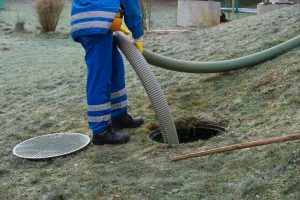The Full Scope of Watewater Pollution
While utilities’ sewer spills and sewer treatment practices remain a factor in pollution of our groundwater and local waterways, it is only a piece of the whole picture. Wastewater utilities having sewer overflows, which are often highlighted, are understandably a concern to the environment and public health, and utilities should continually improve on their system and methods to reduce or eliminate these spills. However, there are other groundwater pollution causes that are sometimes overlooked, such as ones from livestock, agriculture application of fertilizer and pesticides, storm water runoff, and septic systems. When focusing on wastewater pollution, it is important to consider all causes with septic systems and public sewer systems, not just one or the other.
The difference between septic systems and public sewer systems:
- A conventional
 septic system treats (cleans) wastewater onsite, or within the soil on personal property, typically with a septic tank and drainfield.
septic system treats (cleans) wastewater onsite, or within the soil on personal property, typically with a septic tank and drainfield. - A customary [public] sewer system removes wastewater from a property through pipes and pumping systems to a wastewater treatment plant where the wastewater is treated and then discharged back into the environment.
As the Environmental Protection Agency (EPA) states, “Septic systems that are properly planned, designed, sited, installed, operated and maintained can provide excellent wastewater treatment. However, systems that are sited in densities that exceed the treatment capacity of regional soils and systems that are poorly designed, installed, operated or maintained can cause problems. The most serious documented problems involve contamination of surface waters and ground water with disease-causing pathogens and nitrates. Other problems include excessive nitrogen discharges to sensitive coastal waters and phosphorus pollution of inland surface waters, which increases algal growth and lowers dissolved oxygen levels. Contamination of important shellfish beds and swimming beaches by pathogens is a concern in some coastal regions.”
involve contamination of surface waters and ground water with disease-causing pathogens and nitrates. Other problems include excessive nitrogen discharges to sensitive coastal waters and phosphorus pollution of inland surface waters, which increases algal growth and lowers dissolved oxygen levels. Contamination of important shellfish beds and swimming beaches by pathogens is a concern in some coastal regions.”
Septic systems are not usually regulated by a governing body on an ongoing basis, and they are typically monitored by the local health departments:
- before the system is installed,
- if there is new or additional construction being permitted on the property,
- or if a septic system problem is discovered and reported by a citizen.
According to the EPA, “In most states, local health departments issue construction and operating permits to install septic systems under state laws that govern public health protection and abatement of public nuisances. Very few permitting agencies conduct regular inspections of septic systems after they are installed.” Therefore, there is currently no law in our area that requires property owners to uphold their septic systems, including regular septic tank pumping, which is recommended to be done every 3-5 years by the Health Department and the EPA. The community must rely on all of the individual property owners to properly monitor and maintain their septic systems. As stated by the EPA, approximately twenty percent of properties in the United States use septic systems. Although we do not know the exact amount in Baldwin County, we do know that there are many septic systems active on waterfront properties, including Fort Morgan Road, Fish River, Weeks Bay, Mobile Bay and Perdido Bay. In addition, Alabama does not require property owners to disclose a property’s septic system particulars when a property is being sold, and a septic system inspection is not mandatory before a property transfers ownership. This can leave many new property buyers unaware of the septic system’s status or oblivious that they have septic systems.
Several case studies have been completed and articles written about septic system effects on public health and the environment. A few of those readings are listed below.
Septic System Effects on the Environment
Rick Esselment, President & Founder of ESSE & Associates Inc. and former President of the Ontario Onsite Wastewater Association, offered his expertise on the subject. Esselment argues that the issue isn’t with septic tanks, themselves, but instead with the lack of maintenance and knowledge of septic tank owners. He says the issues arise due to the failure to replace septic systems that have exceeded their lifetime. “Septic systems work great. They work really well for a long time, but when they stop working, they really need to be replaced. That’s the contamination issue. When they’re not taken care of and they’re not replaced, they absolutely contaminate the environment. The lack of maintenance, caring and knowledge of septic tanks is what is contributing to contamination, not septic tanks themselves.”
“All along, we have presumed that on-site wastewater disposal systems, such as septic tanks, were working,” said Joan Rose, Homer Nowlin Chair in water research at Michigan State University. “But in this study, sample after sample, bacterial concentrations were highest where there were higher numbers of septic systems in the watershed area.”
Septic Systems Contaminate Groundwater
“A new peer-reviewed study warns that many septic systems do not remove pollutants that may be harmful to human health from sewage before it is discharged to groundwater. Scientists from the Silent Spring Institute monitored—for the first time ever— hormone-disrupting chemicals such as natural estrogen (from urine) and alkylphenols (from detergents), as well as certain pharmaceuticals, as they passed from the septic system into groundwater.
The study looked at a typical septic system in Cape Cod, Mass., where more than 85 percent of residential and commercial properties are serviced by septic systems. Other chemicals detected included caffeine and optical brighteners (also from detergents).”
Community awareness of septic systems and education on septic system preservation is essential in helping to protect public health and waterways. The EPA provides many septic system case studies and demonstrations on their website here. The various case studies contain reports from operating permit programs that reward good system performance to studies on some of the many homeowner awareness programs that are conducted nationwide. In addition, the EPA’s Septic Smart program offers extensive resources on septic systems and details on how and why to maintain them. The Baldwin County Health Department’s website for their Environmental Office also contains information on septic systems, including a list of Do’s and Don’ts. As the Health Department testifies, “Remember, by maintaining your septic system, you protect your pocket book, the health of your family, your community and your environment.”
Find out about BCSS’ protocol for sewer spills here.
Learn about BCSS’ Wastewater Treatment Plants here.



